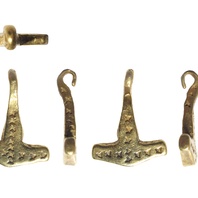
Viking Objects
Hammer-Shaped Pendant (LCNCC: 2015.15)
A gold hammer-shaped pendant with an elongated pentagonal head, popularly called a Thor’s hammer pendant, from Spilsby, Lincolnshire. Hammer-shaped pendants are thought to be amuletic pendants designed to represent Thor’s hammer Mjöllnir. They are common in Scandinavia and in areas of Viking settlement in England. Those found in the Danelaw are generally undecorated or simply decorated, and are thought to have been made in England. The purpose of these pendants has been much speculated about, but nothing definite is known about it. Pendants like this have been found made of lead, copper alloy, silver and gold, showing that many different strata of society could have worn them.
Read More
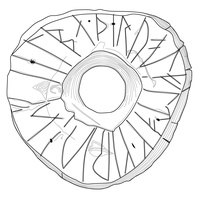
Viking Designs
Drawing of the Saltfleetby Spindle Whorl
Drawing of a lead alloy spindle whorl from Saltfleetby, Lincolnshire showing part of the runic inscription. For further information, see the entry for the original item.
Read More

Viking Objects
Bone Comb with Runic Inscription (1867,0320.12)
An original bone comb case with a runic inscription on it which reads, in translation, “Thorfast made a good comb.” The Vikings were known for looking after their personal hygiene. Combs were not only used for combing your hair but also for removing nits and lice.
Read More
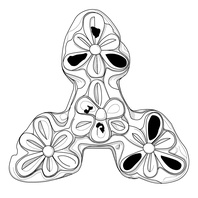
Viking Designs
Drawing of a Carolingian Trefoil Mount
Drawing of a copper alloy and gilded Carolingian mount with niello inlay found in Leicestershire. The mount has holes drilled through it for affixing to a surface, possibly a book, or perhaps to repurpose it as a pendant.
Read More
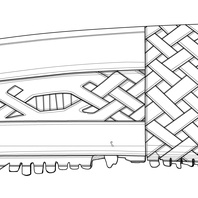
Viking Designs
Drawing of Bone Comb
A drawing of an intricately decorated bone comb found in Lincoln.
Read More
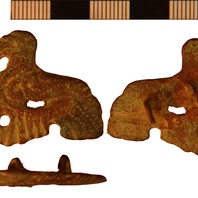
Viking Objects
Viking Bird Brooch (NLM-612074)
This brooch is classified as Weetch’s type 30.C and is decorated with an openwork design representing a bird in profile. For more information on Scandinavian jewellery in England check out our blog: Brooches, Pendants and Pins: Scandinavian Dress Accessories in England.
Read More
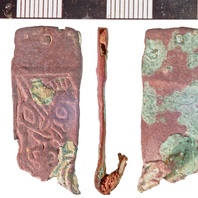
Viking Objects
Borre-Style Strap-End (NLM-F4E3D9)
This strap-end is classified as a Thomas Class E type 4 with Borre-style decoration. Strap-ends came in various styles and were fairly common throughout the Viking world. They were used to decorate the ends of belts and to stop them getting damaged.
Read More
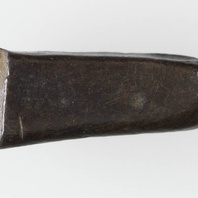
Viking Objects
Silver Ingot (CM.1789-2008)
This silver ingot was made by melting down worked silver cast into a rod and cut into sections. The Vikings arriving in England had a bullion economy where they paid for goods with silver that was weighed to an amount agreed between the buyer and the seller. Hacksilver and silver ingots are the most common evidence for their bullion economy. It took some time for the Scandinavian settlers to adopt a monetary economy like that of the Anglo-Saxons, and both systems were used simultaneously for a while before they fully adopted the new system. They were familiar with monetary economies but they treated coins as just another form of silver before adoption of a monetary economy.
Read More
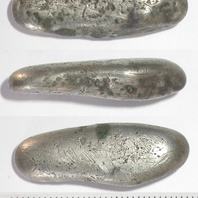
Viking Objects
Breedon Silver Ingot (X.A236.2009.0.0)
A Viking silver ingot which could have been used as bullion in payments or trade transactions, as well as a source of metal for jewellery making. The Vikings arriving in England had a bullion economy where they paid for goods with silver that was weighed to an amount agreed between the buyer and the seller. Hacksilver and silver ingots are the most common evidence for their bullion economy. It took some time for the Scandinavian settlers to adopt a monetary economy like that of the Anglo-Saxons, and both systems were used simultaneously for a while before they fully adopted the new system. They were familiar with monetary economies but they treated coins as just another form of silver before adoption of a monetary economy.
Read More
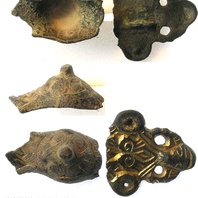
Viking Objects
Fragment of an Equal-Armed Brooch (SWYOR-FAFC04)
A fragment of a Viking Age equal-armed brooch found at Harworth Bircotes, Nottinghamshire. This fragment is the boss of the brooch and resembles brooches found at Birka, Sweden. Its decoration consists of a Borre style animal with gripping arms or legs. This is one of only six Scandinavian, Viking period equal-armed brooches recorded in England. For more information on Scandinavian jewellery in England check out our blog: Brooches, Pendants and Pins: Scandinavian Dress Accessories in England.
Read More

Viking Talks
Danelaw Saga
Invade … immigrate … integrate … inspire. The exhibition ‘Danelaw Saga’ ran from 15th December 2017 to 8th April 2018 and told the tale of how the Vikings shaped the East Midlands. In the 860s the Great Heathen Army invaded the East Midlands, agreeing peace with the Anglo-Saxon King, Alfred the Great, in the 870s. The agreement established the Danelaw where Viking laws and government reigned, giving the Vikings half of England to rule. They settled in the five boroughs of the Danelaw (Derby, Leicester, Lincoln, Nottingham and Stamford) and integrated with the existing population. The legacy of these settlers can still be seen today in place-names like Gunthorpe, Nottinghamshire, named after Gunnhild, a woman with a Viking name. This film about the exhibition ‘Danelaw Saga’ tells a local story of Viking culture with artefacts, maps and medieval documents from Manuscripts and Special Collections at the University of Nottingham and from regional museums. The exhibition presented an opportunity to see extraordinary Viking works brought together and to learn about the places whose names evoke the Viking past. Visitors could map the routes of Viking expeditions, view coins brought from the Middle East to the East Midlands, and explore their heritage further through artefacts and jewellery worn by the Viking women that settled in the East Midlands. ‘Danelaw Saga’ tells the story of Viking heritage hidden in plain sight, from place names in use since they were given by the Vikings to modern literature inspired by the East Midlands’ own Viking past. ‘Danelaw Saga’ uncovers the legacy of the Vikings on our doorstep.
